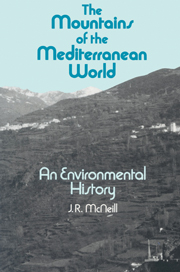Book contents
- Frontmatter
- Contents
- List of Illustrations and Tables
- Preface
- Note on Transliteration
- List of Abbreviations
- 1 The Argument: Ecology, Economy, Shells, and Skeletons
- 2 Mediterranean Mountain Environments
- 3 The Deep History of Mediterranean Landscapes
- 4 Material Life in the Mountain Environment, 1700–1900
- 5 Population, Settlement, and Landscapes
- 6 Political Economy and Mountain Landscapes
- 7 The Changing Landscape since 1800
- 8 Conclusion
- Bibliography
- Index
5 - Population, Settlement, and Landscapes
Published online by Cambridge University Press: 29 September 2009
- Frontmatter
- Contents
- List of Illustrations and Tables
- Preface
- Note on Transliteration
- List of Abbreviations
- 1 The Argument: Ecology, Economy, Shells, and Skeletons
- 2 Mediterranean Mountain Environments
- 3 The Deep History of Mediterranean Landscapes
- 4 Material Life in the Mountain Environment, 1700–1900
- 5 Population, Settlement, and Landscapes
- 6 Political Economy and Mountain Landscapes
- 7 The Changing Landscape since 1800
- 8 Conclusion
- Bibliography
- Index
Summary
Sunk are the bowers, in shapeless ruin all,
And the long grass o'ertops the mouldering wall,
And trembling, shrinking from the spoiler's hand,
Far, far away thy children leave the land.
Ill fares the land, to hastening ill a prey,
Where wealth accumulates, and men decay:
Princes and lords may flourish, or may fade;
A breath can make them, as a breath has made;
But a bold peasantry, their country's pride,
When once destroyed, can never be supplied.
Oliver Goldsmith, “The Deserted Village” (1770)The government is very keen on amassing statistics. They collect them, add them, raise them to the nth power, take the cube root and prepare wonderful diagrams. But, you must never forget that every one of these figures comes in the first instance from the village watchman, who just puts down what he damn pleases.
Sir Josiah StampThe relationship between population history and landscape evolution is not a simple one. Each affects the other in an endless pas de deux. In the Mediterranean mountains, population growth in rural settings usually meant land clearing, vegetation change, often accelerated erosion. Population decline generally meant landscape neglect, often accelerated erosion, but eventual revegetation by aggressive, opportunistic species – except where erosion had gone too far. Population stability, a rare condition in times past, has generally meant stability in vegetation and more modest rates of erosion, although all this depended on the systems of husbandry involved, the slopes, soil characteristics, climate, and more.
- Type
- Chapter
- Information
- The Mountains of the Mediterranean World , pp. 147 - 220Publisher: Cambridge University PressPrint publication year: 1992



